You can’t have a conversation about the best regional cuisines in Mexico without including Michoacán. It may not be as globally recognized or celebrated as the cuisines of Puebla, Oaxaca, or Yucatan, but anyone who knows Mexican food will tell you that Michoacán belongs to that conversation.
Perhaps part of the reason why Michoacán (and its cuisine) is often overlooked by foreign travelers is its current status as a red-level Mexican state. Due to the threat of crime and kidnapping, the US Department of State advises against all travel to Michoacán, except to two cities – Morelia and Lazaro Cardenas.
To be honest, I almost didn’t include Michoacán in our Mexico itinerary because of those warnings. But we travel for food so we couldn’t possibly leave Mexico without exploring Michoacán cuisine.
We spent two weeks in Morelia and the nearby pueblo magico of Patzcuaro to experience what’s often been described as the “soul food of Mexico”. Here’s what we found.
MICHOACAN FOOD QUICK LINKS
To help plan your Morelia visit, we’ve compiled links to recommended hotels, tours, and other travel services here.
HOTELS
Popular hotels in Centro, the best area to stay for first-time visitors to Morelia.
- Luxury: Casa Grande Hotel Boutique
- Midrange: Casona Origen
- Budget: HostalMich by Rotamundos
TOURS
- Sightseeing Tour: Downtown City Tour
- Pueblos Magicos Tour: 3 Magic Towns Tour
OTHER SERVICES
Save This on Pinterest!
No time to read this guide on Michoacan food? Click on the save button and pin it for later!
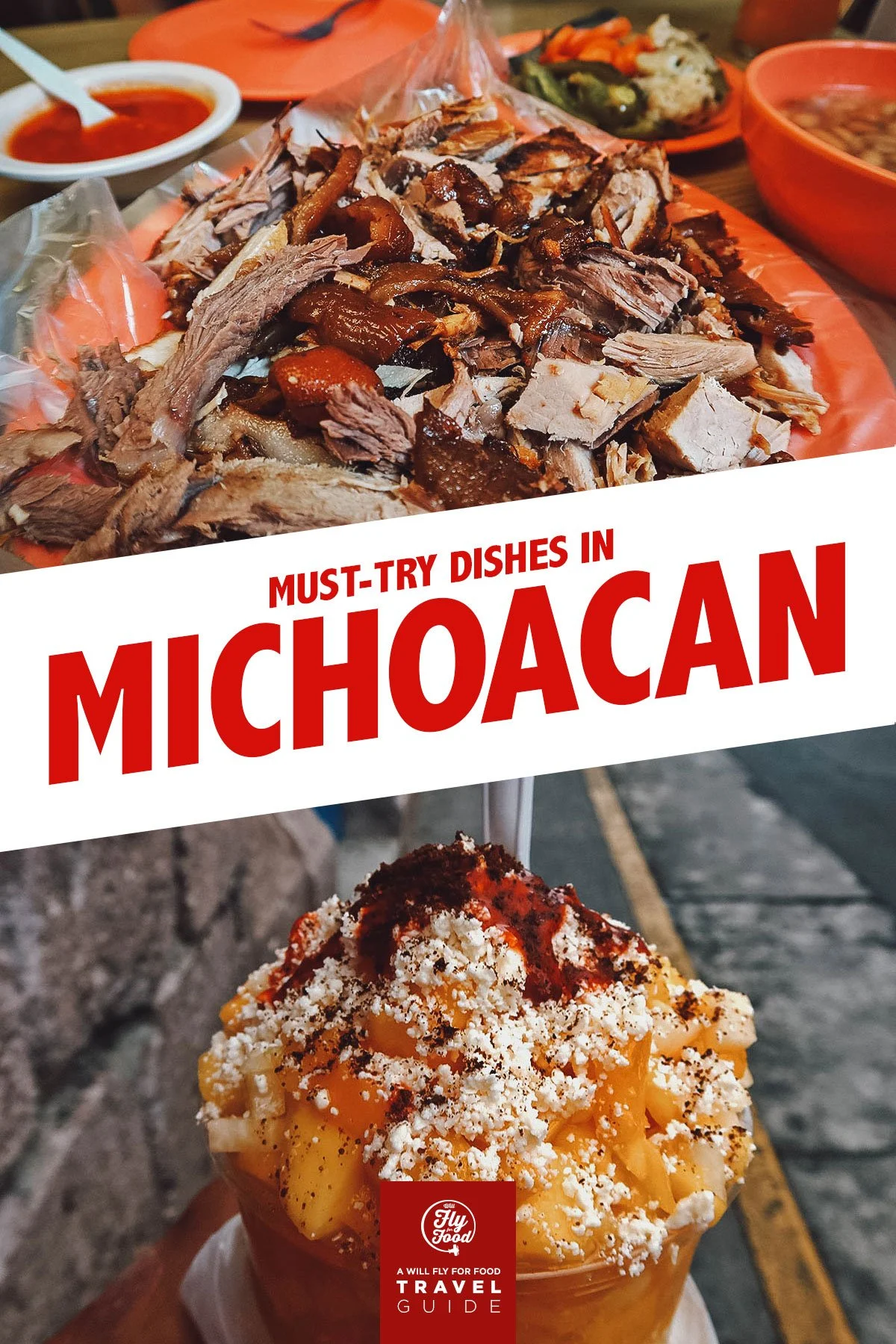
WHAT IS TRADITIONAL MICHOACÁN CUISINE?
Michoacán cuisine can best be described as soulful and simple, but complex. According to James Beard Award-winning chef Pati Jinich, dishes in Michoacán are typically made with fewer ingredients than those from other Mexican regions, though the end result is typically more complex.
Take carnitas for example. Originally from Michoacan, carnitas is enjoyed in many parts of Mexico but Michoacan-style carnitas is still considered the best. It’s made in the simplest way possible – with just pork, lard, and salt.
In Michoacán, a whole pig is expertly broken down and slow-cooked in its own fat to produce a delicious and complex-tasting dish with a minimal number of ingredients. We’ve enjoyed carnitas in many parts of Mexico but the carnitas in Michoacán truly is a cut above the rest.
Chef Jinich also praises the quality of the ingredients in Michoacán. The Tierra Caliente region in particular enjoys an abundance of natural resources. Michoacán is the country’s top producer of avocados, accounting for up to 92% of Mexico’s total crop. Aside from avocados, other ingredients often used in Michoacán cooking include tomatillos, guava, tamarind, dried pasilla chilis, peruano beans, and chayote root.
It was interesting to learn that queso cotija (cotija cheese) – the crumbly cheese often used as a topping on many Mexican dishes – hails from Cotija de la Paz, while the super popular chain of La Michoacana ice cream shops is originally from the small town of Tocumbo. Both towns can be found in the western region of Michoacán state.
But perhaps the most distinguishing feature of Michoacán cuisine is something that can’t be understood until you actually taste it – its soulfulness. The people of Morelia are some of the warmest and most welcoming we’ve encountered thus far in Mexico, and that warmth carries over to their food. In many ways, it reminded us of Filipino food – simple dishes that are meant to fill you up and bring you a sense of comfort.
Michoacán food is Mexican soul food. Taste hearty dishes like sopa tarasca, morisqueta, churipo, and atapakua and you’ll quickly see why Michoacán is known as the soul of Mexico.
WHAT FOOD IS POPULAR IN MICHOACÁN?
Aside from carnitas, corundas, and a few other dishes, many of the entries on this list are not that easy to find in Morelia. We’ve never had a problem finding regional dishes in any Mexican City but in Morelia, we had to go door-to-door and go through each restaurant’s menu.
I think the reason for this is that many of Michoacán’s specialties are typically home-cooked, family-style dishes that aren’t usually served at restaurants, which again speaks to the soulful nature of Michoacán food.
In any case, we were lucky to find delicious examples for each of these dishes in Morelia. Check out our Morelia restaurant guide for suggestions on where to try them.
1. Carnitas
We tried many delicious dishes in Morelia, but carnitas was easily our favorite dish. The carnitas in Michoacán really is on a different level.
Carnitas literally means “little meats” and refers to a Mexican dish of pork confit slow-cooked in lard. It typically consists of a whole pig that’s butchered and then cooked in its own rendered fat for two to four hours in a large cauldron.
The slow-cooking process results in incredibly tender and juicy meat that’s chopped up into smaller chunks and eaten in corn tortillas with refried beans, salsa, pico de gallo, pickled vegetables, and guacamole.
In other parts of Mexico, the pork is usually chopped up into tiny pieces and served to you on tortillas, but in Michoacán, they give the meat to you in larger chunks. They give you the corn tortillas and condiments on the side so you’re free to assemble the tacos yourself.
As described, carnitas can be prepared in different ways depending on where it’s from, but Michoacan-style carnitas is widely considered to be the best. We were already in love with carnitas before visiting Morelia but even more so after our trip. The carnitas here is absolutely delicious.
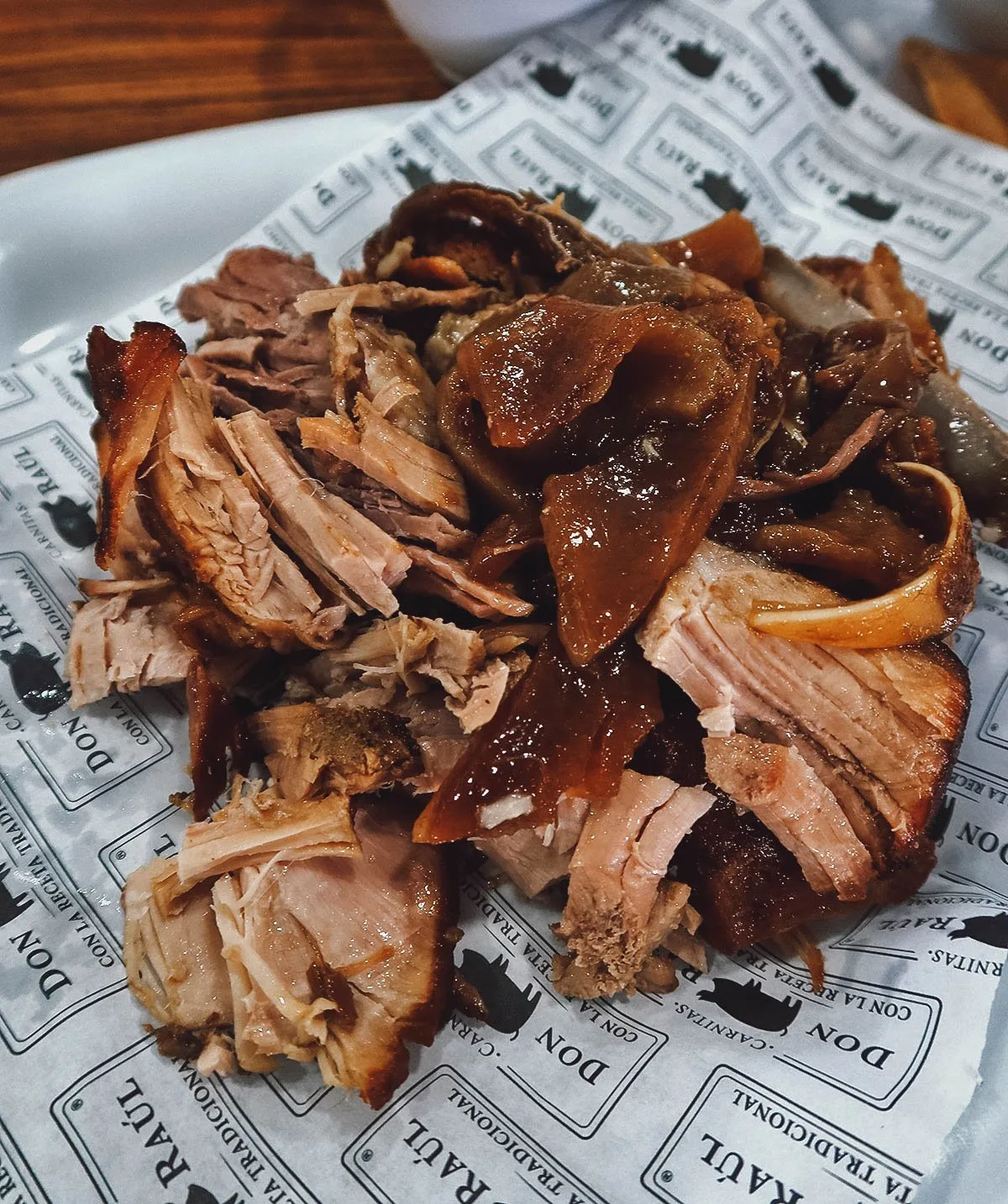
We went to five carnitas restaurants in Morelia and they all served it in the same way. You can get it in varying amounts from a quarter kilo to a kilo of meat cut from different parts of the pig. A half kilo of meat is usually good enough for two people.
You can request for a specific cut of pork but surtido or an “assortment” is standard. It’ll typically be served with a few slivers of cueritos or pork skin. For me, the cueritos is what makes carnitas truly special. It has a wonderful gelatinous texture that goes amazingly well with the meatier cuts of pork.
In Michoacán, carnitas is traditionally prepared in large copper cauldrons produced in Santa Clara del Cobre, a pueblo magico (magical town) with a long history of copper production in central Michoacán state.
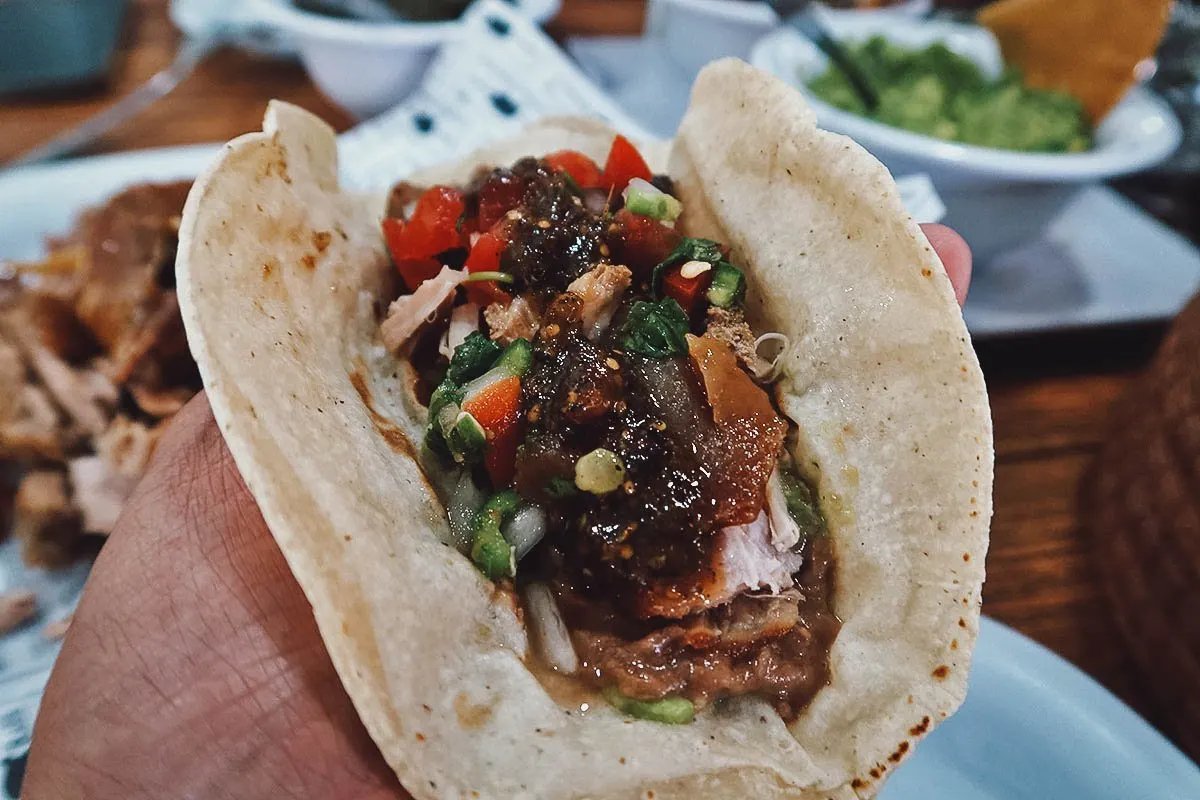
2. Corundas
Aside from the Yucatan, no other region in Mexico is as recognized for its tamales as Michoacán. You can find many different preparations for tamales in Michoacán, none more famous perhaps than corundas.
Corundas are triangular-shaped tamales made with a sturdier dough wrapped in corn leaf. Steamed until golden, they’re often filled with savory ingredients and are typically eaten with a side of sour cream and red salsa.
Corundas are one of the easiest Michoacán dishes to find in Morelia. Many Mexican restaurants and street food stalls serve corundas, either on its own or as a side dish to larger entrees.
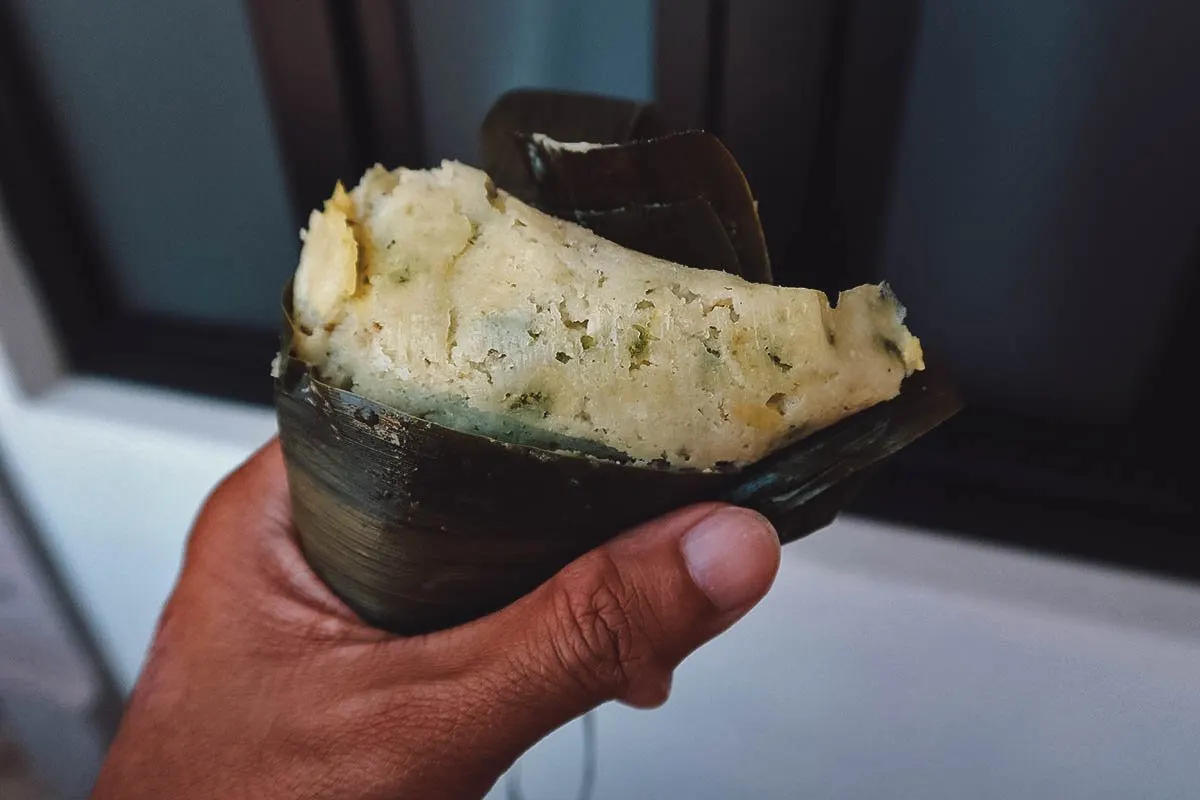
3. Uchepos
Uchepos are another common type of tamal in Michoacán. Unlike corundas and many other types of Mexican tamales, uchepos are made with fresh instead of dried corn and are often sweet.
Uchepos can be eaten on their own or topped with salsa, sour cream, or cotija cheese. When eaten for dessert, they’re typically served with sweetened condensed milk.
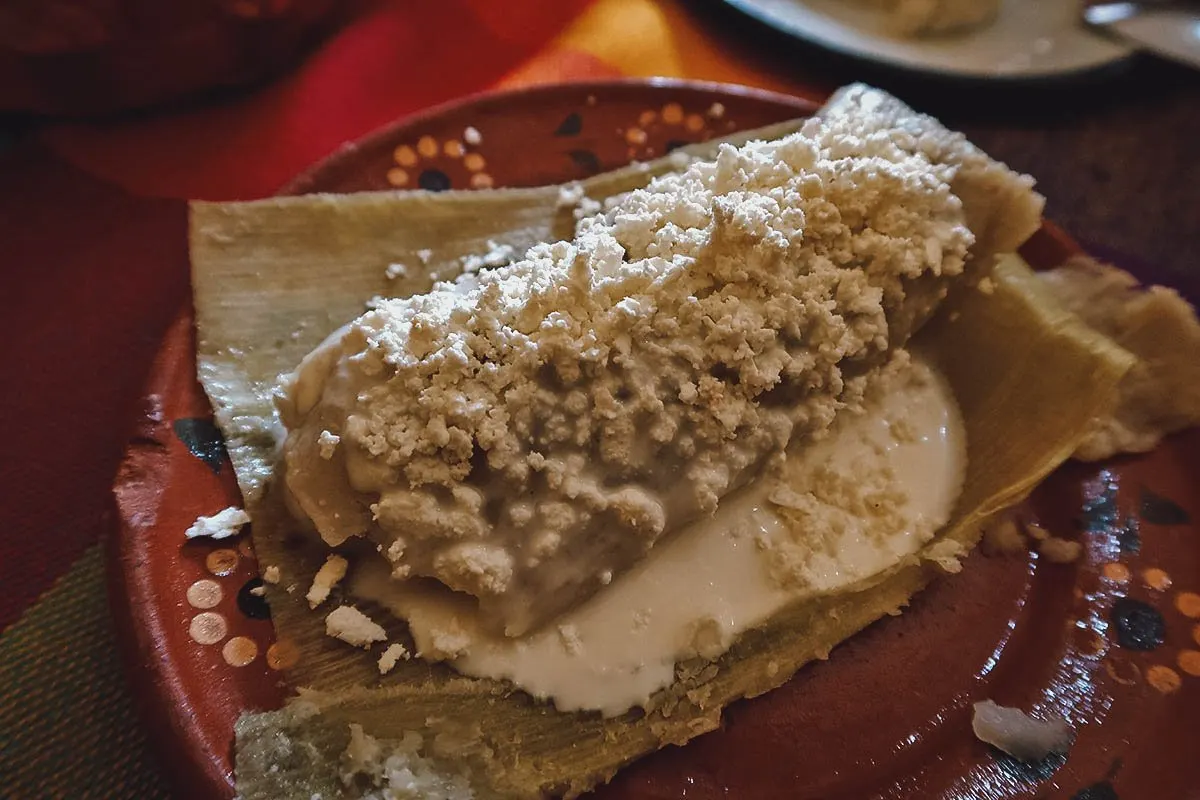
4. Charales
One of the best day trips you can make from Morelia is to Pátzcuaro, a charming pueblo magico about an hour southwest of Morelia. If you do decide to visit Pátzcuaro, then you absolutely need to try charales. It’s a term that can refer to both the dish and the type of fish used to make it.
Charales is a Michoacán dish of lightly battered and fried Chirostoma fish. This genus of fish can be found in the waters of Mexico’s Lerma River basin, which includes Lake Pátzcuaro and Chapala. Chirostoma fish can vary in size but the species used for the dish typically measure around three to four inches long.
We had charales twice in Michoacán, once in Morelia and another time in Pátzcuaro. Both times, the charales were lightly battered and fried but I read they can be prepared in other ways as well. They can be added as an ingredient in omelettes or made into fried pancakes or fritters.
However they’re made, charales are absolutely delicious and something you need to try while in Michoacán.
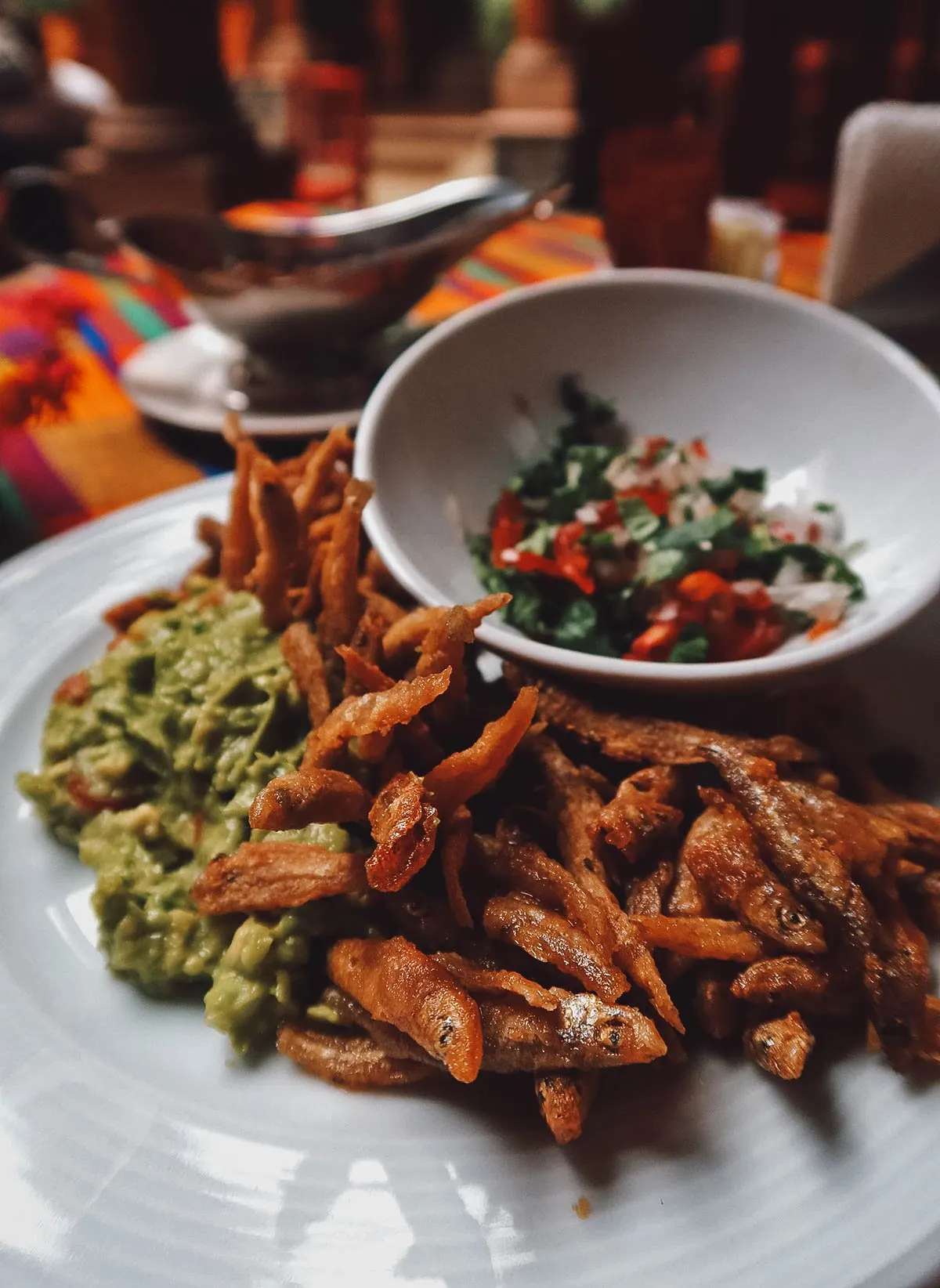
5. Sopa Tarasca
I found sopa tarasca to be one of the most surprising dishes in Michoacán cuisine. I’m not a big soup person so I expected it to be like any other bowl of Mexican soup, but it turned out to be incredibly delicious.
Sopa tarasca refers to a hearty Mexican pinto bean soup flavored with tomatoes, onions, garlic, ancho peppers, herbs, and seasonings. It’s often garnished with strips of fried tortilla, queso cotija, avocado, and sour cream.
Sopa tarasca, like many of the dishes on this list, is a tasty example of local Purépecha cuisine. The Purépecha people are an indigenous group that’s inhabited the northwestern region of Michoacán for over a thousand years.
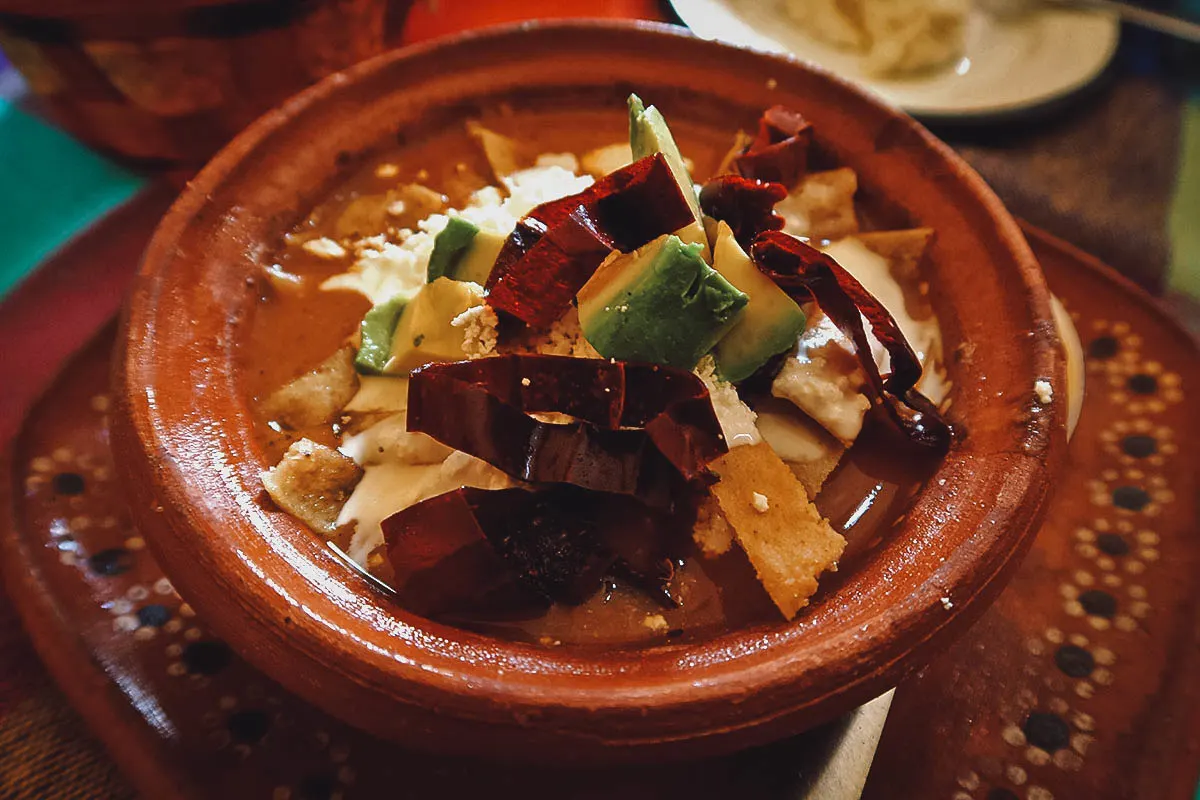
6. Atapakua
Like sopa tarasca, atapakua is an eye-opening Michoacán dish. It isn’t the most appetizing-looking dish on this list but it’s absolutely redolent with flavor.
Atapakua refers to a type of pre-Hispanic Purépecha stew thickened with masa. Depending on the cook, it can be made with a variety of different ingredients like ancho chilis, fresh corn, tomatoes, garlic, pepitas (pumpkin seeds), sorrel, and yerba buena. When made with pepitas as its main ingredient, you can think of it as a type of Michoacán pipian.
Before the Spaniards arrived, atapakua was thought to be made with just plant-based ingredients like vegetables and legumes. Today, it’s often made with animal proteins like beef and pork and is usually reserved for weddings and funerals.
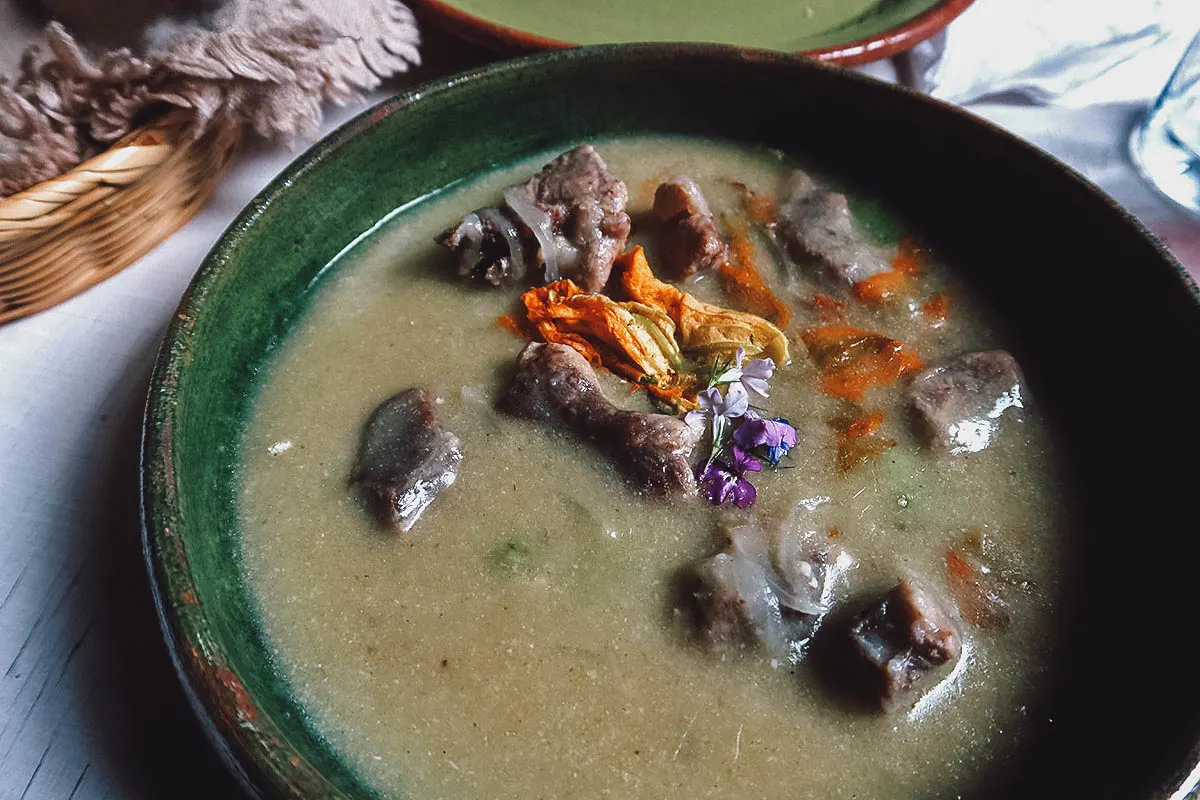
7. Churipo
Churipo is another delicious Purépecha stew that you need to try in Michoacán. As you can probably tell from its color, it’s spicier than atapakua and is traditionally prepared with beef, vegetables, corn, chili peppers, herbs, and corundas.
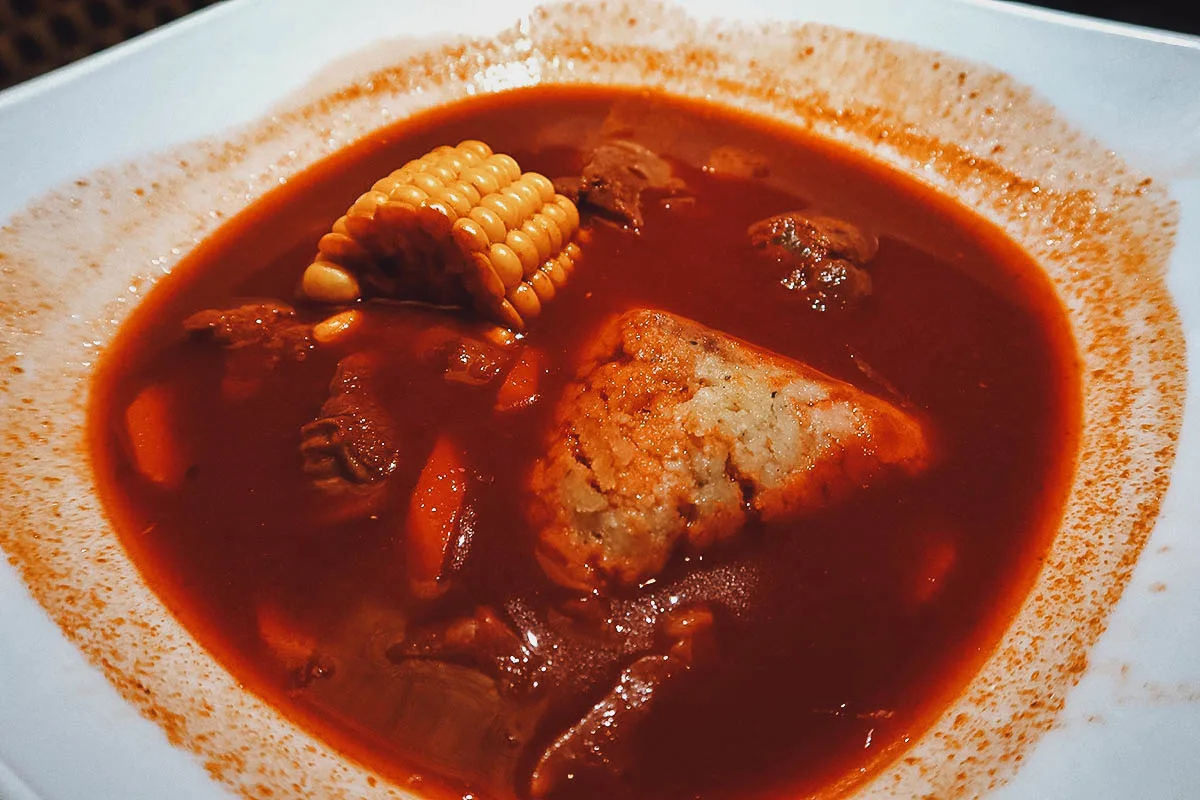
8. Morisqueta
Morisqueta, for me, is a great example of why Michoacán food is referred to as Mexican soul food. It’s a hearty and comforting dish of white rice and cooked pinto beans topped with sour cream and crumbled queso fresco.
The term morisqueta refers specifically to the basic dish of white rice and beans but it’s traditionally served to accompany different types of stews and soups.
What you’re looking at below is an Apatzingán version of morisqueta. It’s traditionally served with pork ribs braised in tomato sauce.
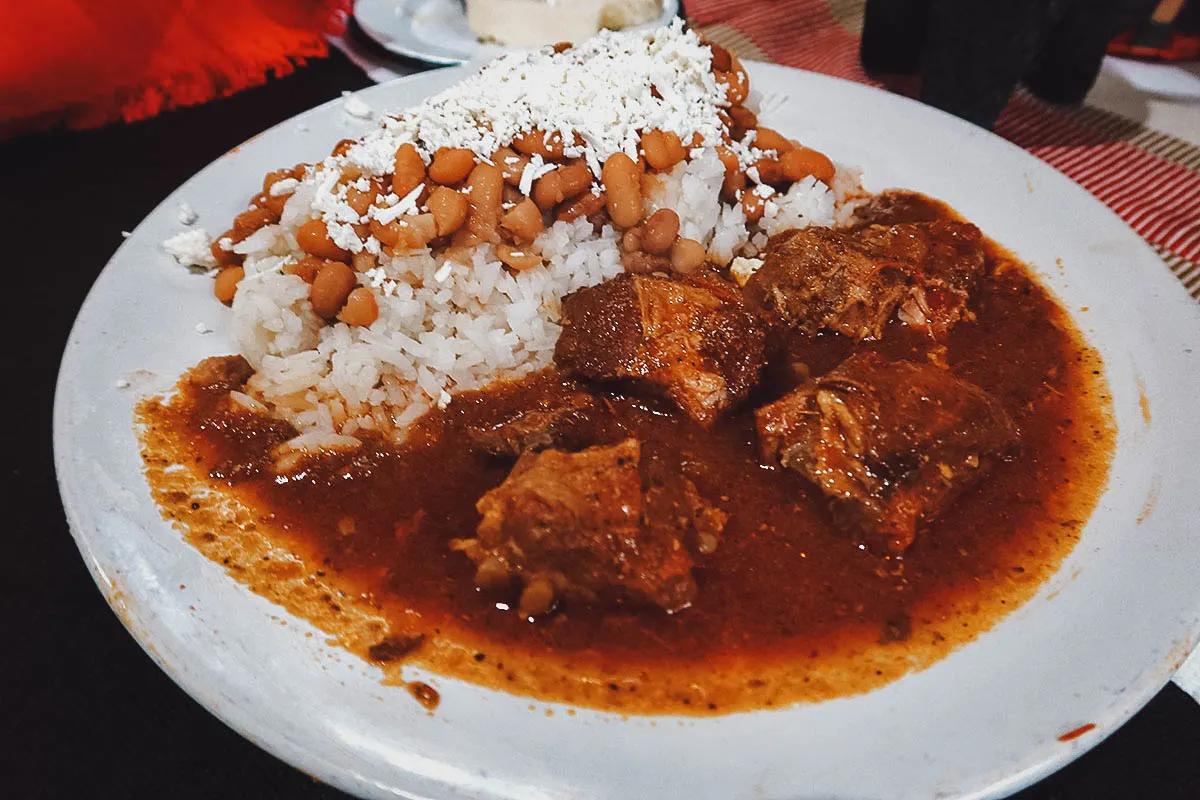
9. Aporreadillo
If you enjoy bold punches of flavor in your food, then you’re going to love aporreadillo. It refers to a spicy dish made with dried and salted meat that’s been beaten with a stone, shredded, and then cooked with egg in a sauce made from different types of chili pepper, onion, garlic, and spices.
Aporreadillo is a popular dish in both Michoacán and Guerrero regional cuisines. It’s typically eaten for breakfast or dinner, usually with a side of rice and refried beans.
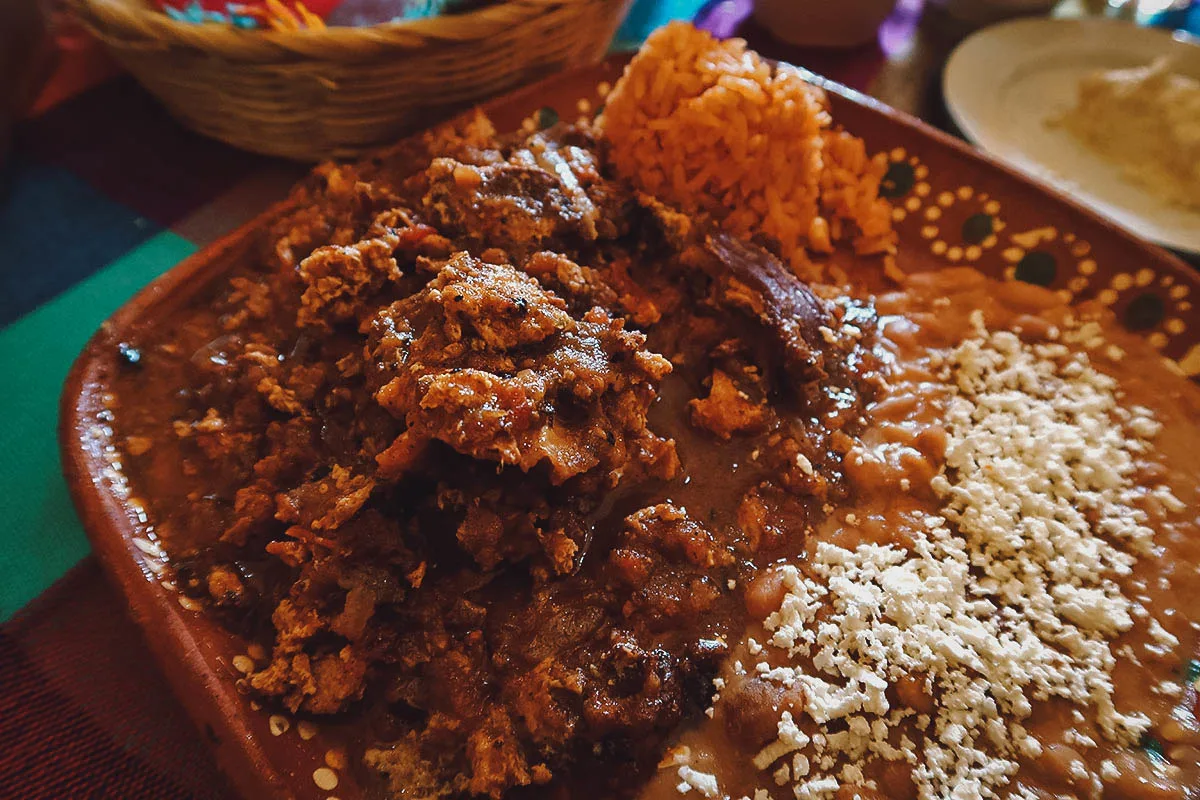
10. Xanducata
As previously described, it was surprisingly hard to find many of these traditional dishes at Mexican restaurants in Morelia’s Historic Center. So when we did find one, we ordered as many dishes as we could. La Guarecita de San Agustin was one of those restaurants.
We ordered churipo, charales, chongo zamorano, and this Purépecha dish that we hadn’t come across in our research – xanducata de pollo. Xanducata refers to a thick mole-like sauce that’s typically served with rice and some type of meat, in this case chicken.
There isn’t as much information about this dish online but based on this one xanducata recipe, it appears to be another type of Michoacán pipian (made with pepitas). Interestingly, there’s a minty version of xanducata called xanducata de novia y novio that’s traditionally prepared for a bride and groom.
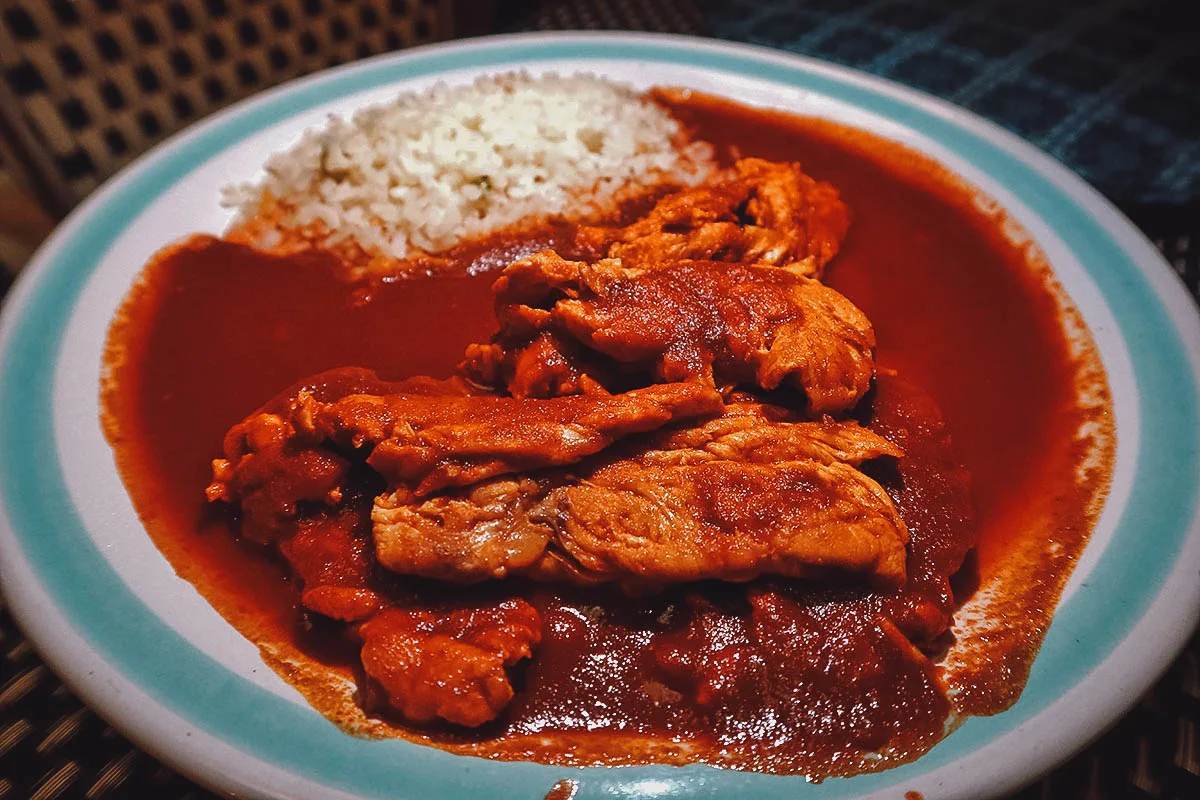
11. Pollo Placero (Enchiladas Morelianas)
Like tacos, enchiladas are among our favorite dishes to eat in Mexico. There are many different types of enchiladas you can try in Mexico but in Michoacán, you need to try pollo placero.
Also known as enchiladas morelianas or enchiladas placeras, pollo placero refers to a popular Michoacán dish that used to be served in the plazas of Michoacan’s Spanish colonial cities. It’s made with oregano-seasoned chicken fried in lard and then served with enchiladas, carrots, and potatoes coated in an ancho chili sauce.
If you’ve eaten your way through Guanajuato or Queretaro, then you may find it similar to enchiladas mineras or enchiladas queretanas.
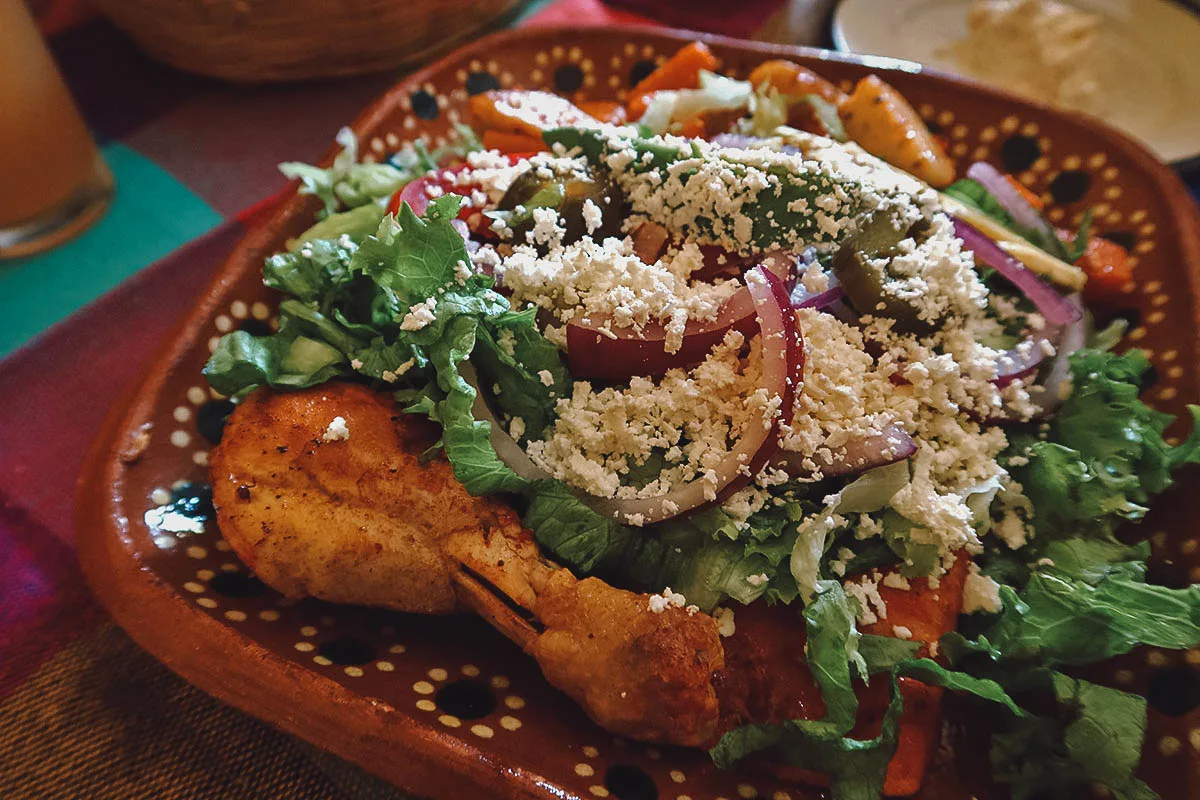
12. Gaspachos
No guide to Michoacán cuisine can ever be complete without gaspachos. While the word gazpacho may conjure up images of a cold Andalusian soup made with raw blended vegetables, gaspacho in Michoacán refers to a dessert snack made with chopped fruit, onions, orange juice, lime, chili, and queso cotija.
A specialty of Morelia, you’ll find gaspacho stalls and people eating this fruity snack throughout the city at all times of the day. There are different variations of gaspacho but the basic version is made with finely chopped mango, jicama, pineapple, and watermelon.
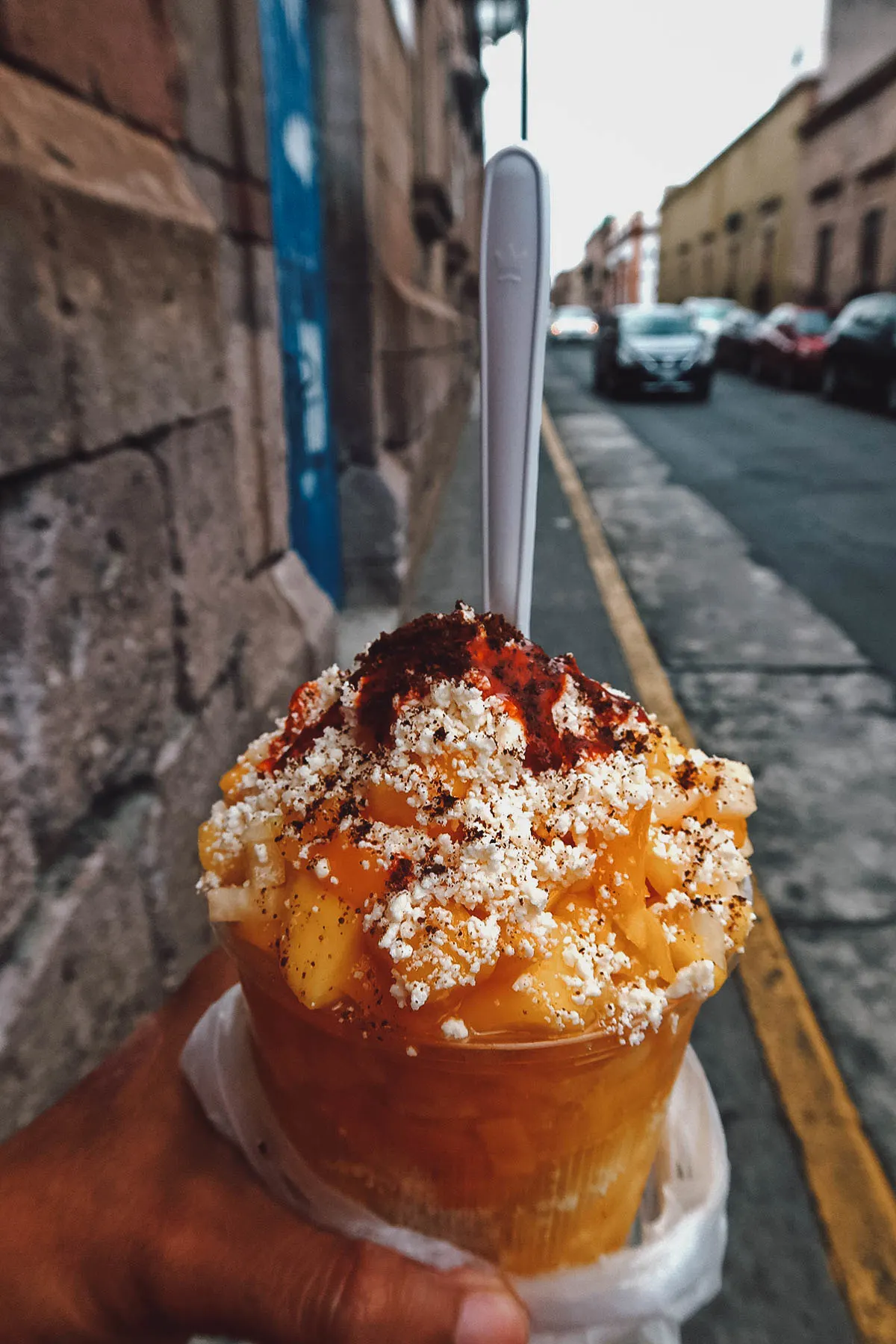
13. Chongos Zamoranos
If you have a soft spot for the sweeter things in life, then you need to sink your teeth into this Michoacán dessert called chongos zamoranos. Originally from Zamora de Hidalgo, it’s a syrupy sweet curdled milk dessert made from milk, sugar, cinnamon, and rennet tablets.
Chongos zamoranos have a soft and spongey texture similar to some types of cheese. Be warned that this dessert is cloyingly sweet so one small cup will probably be enough for two.
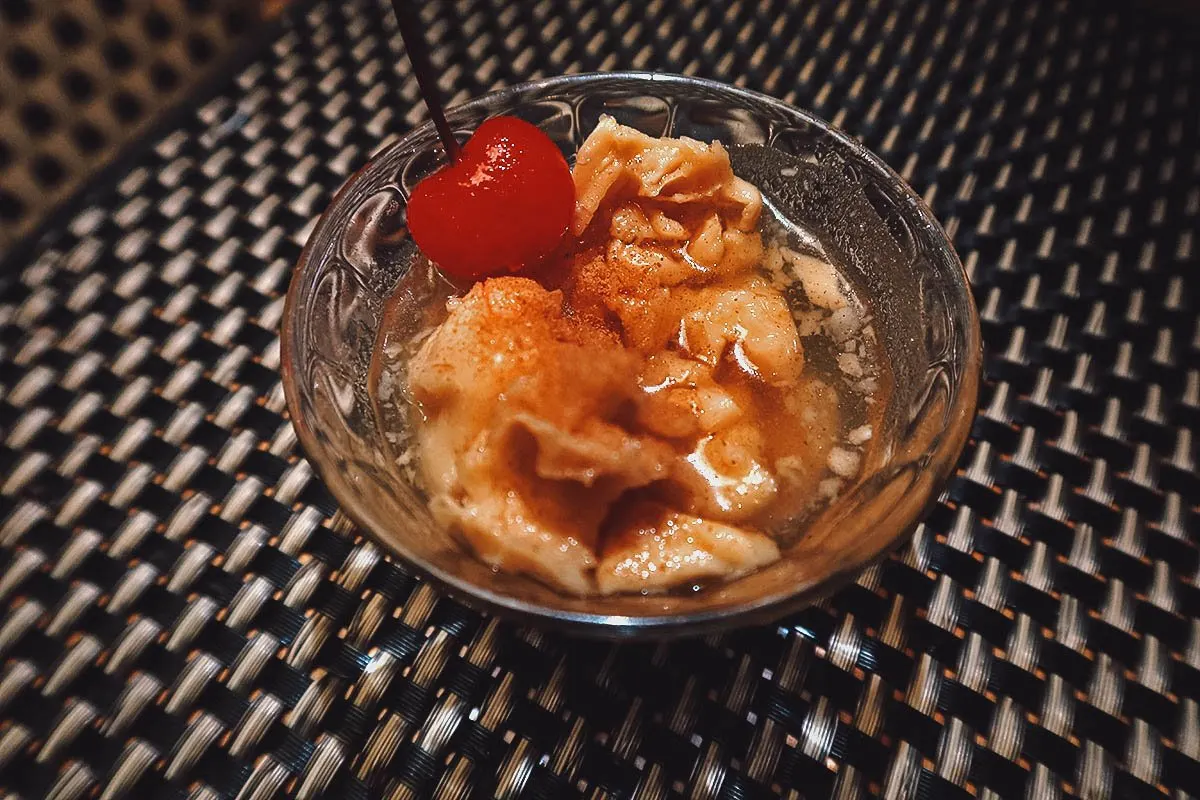
14. Nieve de Pasta
Aside from charales, nieve de pasta is a Michoacán dish that you need to try in Pátzcuaro. Nieve de pasta literally means “paste ice cream”. It’s a perfect way of describing this ultra-thick and pasty ice cream that tastes similar to condensed milk or dulce de leche.
Nieve de pasta was invented by the Neveria La Pacanda ice cream shop in Pátzcuaro over a hundred years ago. According to this Mexican food blog, it’s made by combining various ingredients like milk, sugar, baking soda, vanilla, and honey in a copper saucepan (from Santa Clara del Cobre).
I asked an ice cream shop owner in Morelia if nieve de pasta was a type or flavor of ice cream, and she said it’s both. Nieve de pasta natural tastes like dulce de leche but it can also be used as a base to make other flavors like mamey (sapodilla), mango, strawberry, peanut, corn, and mezcal.
You can find nieve de pasta in Morelia but it’s a far cry from the real deal at Neveria La Pacanda in Pátzcuaro. It’s super thick and pasty, almost like an ice cream version of New York cheesecake.
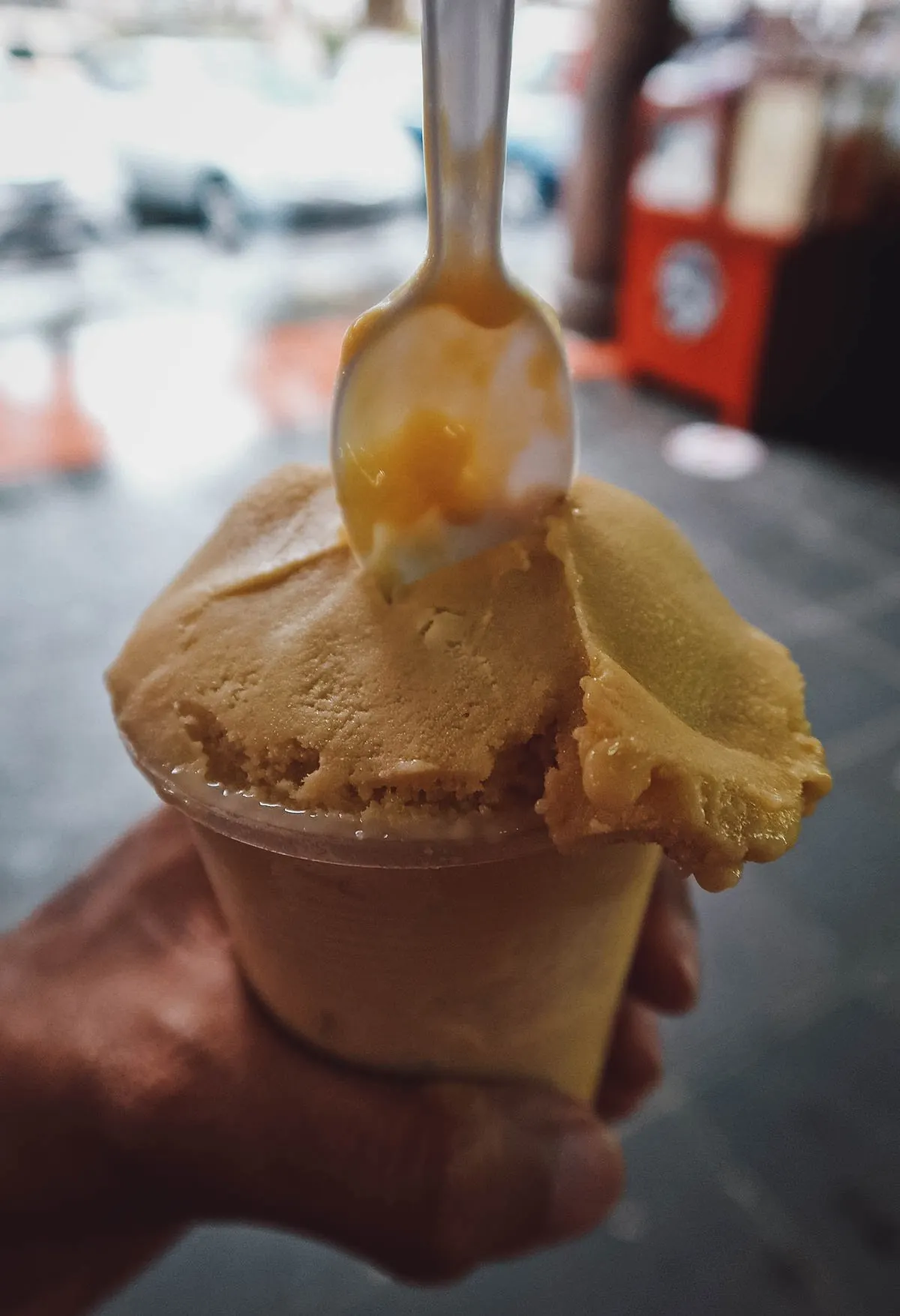
15. Dulces Tipicos de Michoacan
Michoacán is famous for its traditional sweets. Similar to the dulces tipicos of Puebla, the dulces tipicos de Michoacán (“typical sweets from Michoacán”) were originally produced in convents during the colonial era. Today, they’re one of the best food souvenirs you can buy in Morelia.
Fruit jellies called ates are the most well-known (and delicious) but there are many different types of dulces tipicos you can buy in Morelia. Some of our favorites include morelianas, mazapanes, cocadas, and serpentinas. Even chongos zamoranos can be considered a type of dulce tipico from Michoacán.
Like Puebla, rompope or Mexican eggnog is popular in Michoacán as well.
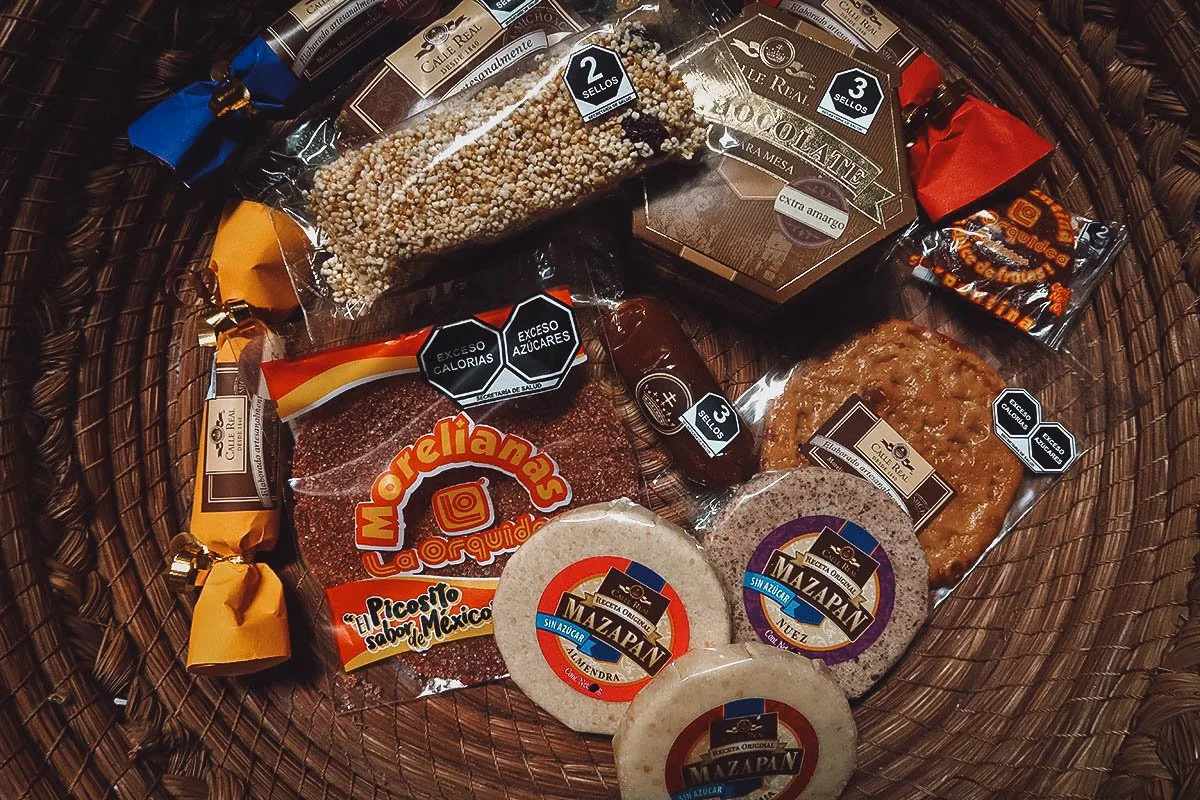
BONUS: Charanda
This bonus entry isn’t a dish but if you like to drink, then you need to try charanda. It’s a sweet and smooth alcoholic spirit made from sugarcane, similar to rum.
Like mezcal and tequila, charanda enjoys Protected Designation of Origin status (PDO). This means that only spirits distilled from sugar cane in sixteen municipalities of Michoacán can carry the label “charanda”.
Charanda, in the Purépecha language, means “red-colored soil”. It’s named after the hilly area called Cerro de la Charanda where the first distillery was built.
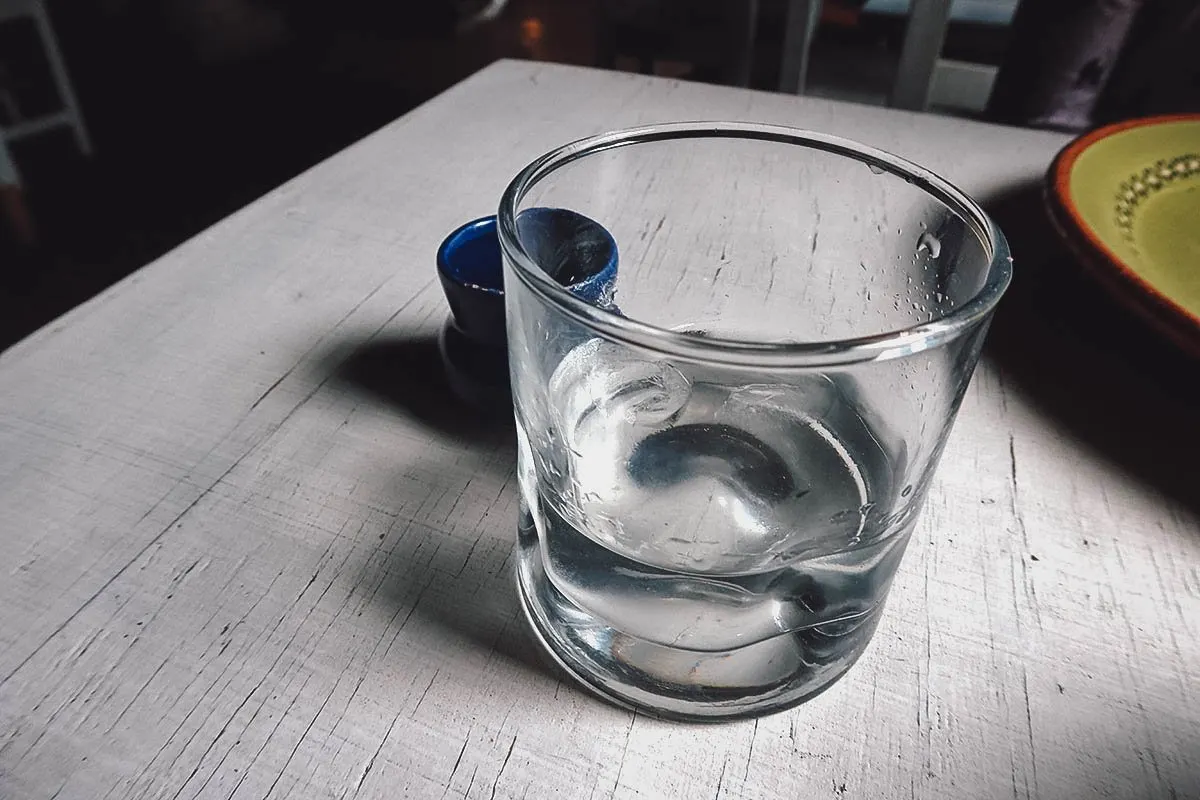
FINAL THOUGHTS ON MICHOACÁN CUISINE
I am so happy we decided to visit Morelia and Michoacán. When it comes to cities with the best and most interesting Mexican food, there’s no question that Michoacán belongs in that discussion. It’s right up there with Puebla, Oaxaca, Yucatan, and Jalisco.
The US Department of State’s advisory made me a bit nervous to visit Michoacán but any fears were quelled within the first day of being in Morelia. I’m not exaggerating when I say that Michoacán is home to some of the warmest and kindest people we’ve met so far in Mexico. We felt that within the first couple of days of being there. Everyone treated us so well and that made the experience, and the food, that much more memorable.
I’m not an expert on the security issue in Michoacán but I can say from experience that we felt completely safe in Morelia. It’s like any other major city in Mexico. As long as you use common sense and observe the usual travel safety guidelines, then you should be fine. I suggest checking the US Department of State’s latest advisory before making a decision.
If you do decide to visit Morelia, then you’ll be in for quite a treat. Because not only does Morelia have some of the best food in Mexico, but it’s home to arguably the country’s most breathtaking architecture as well.
Disclosure
Some of the links in this Michoacan food guide are affiliate links, meaning we’ll earn a small commission if you make a purchase at no added cost to you. As always, we only recommend products and services that we use ourselves and firmly believe in. We really appreciate your support as this helps us make more of these free travel guides. Muchas gracias!

